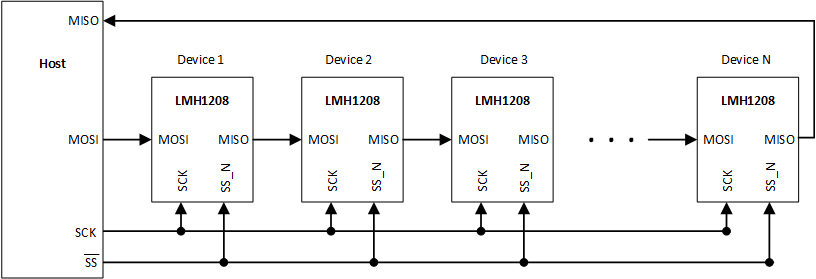SNLS569C March 2017 – May 2020 LMH1208
PRODUCTION DATA.
- 1 Features
- 2 Applications
- 3 Description
- 4 Revision History
- 5 Pin Configuration and Functions
- 6 Specifications
-
7 Detailed Description
- 7.1 Overview
- 7.2 Functional Block Diagram
- 7.3 Feature Description
- 7.4 Device Functional Modes
- 7.5 Register Maps
- 8 Application and Implementation
- 9 Power Supply Recommendations
- 10Layout
- 11Device and Documentation Support
- 12Mechanical, Packaging, and Orderable Information
Package Options
Mechanical Data (Package|Pins)
- RTV|32
Thermal pad, mechanical data (Package|Pins)
- RTV|32
Orderable Information
7.4.2.4 SPI Daisy Chain
The LMH1208 supports SPI daisy-chaining among multiple devices, as shown in Figure 17.
 Figure 17. Daisy-Chain Configuration
Figure 17. Daisy-Chain Configuration Each LMH1208 device is directly connected to the SCK and SS_N pins of the host. The first LMH1208 device in the chain is connected to the host’s MOSI pin, and the last device in the chain is connected to the host’s MISO pin. The MOSI pin of each intermediate LMH1208 device in the chain is connected to the MISO pin of the previous LMH1208 device, thereby creating a serial shift register. In a daisy-chain configuration of N × LMH1208 devices, the host conceptually sees a shift register of length 17 × N for a basic SPI transaction, during which SS_N is asserted low for 17 × N clock cycles.